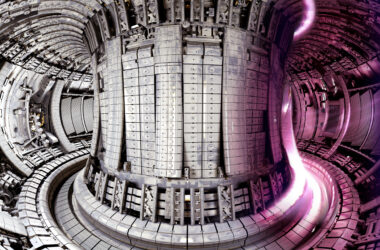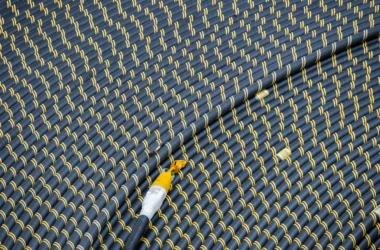Fusion power offers a clean, virtually limitless energy source of the future. Now, scientists at the Joint European Torus (JET), operated by the United Kingdom Atomic Energy Authority (UKAEA) and the EUROfusion consortium, have made a groundbreaking discovery that brings us one step closer to unlocking the incredible potential of fusion energy.
The team has developed a method for achieving “clean” plasma by creating a heat barrier that prevents tungsten contaminants from interfering with the fusion process.
To understand this breakthrough’s significance, we need to know a bit about the fusion process. Fusion occurs when the nuclei of two atoms combine, releasing massive amounts of energy. The challenge lies in creating and maintaining this reaction’s enormously high temperatures and pressures. That’s where the tokamak, a doughnut-shaped reactor, comes in, using powerful magnetic fields to confine and heat the plasma to temperatures exceeding 100 million degrees Celsius.
Tungsten, a metal with a high melting point, is used in the inner walls of tokamaks to withstand the intense heat produced during fusion. However, when hot plasma interacts with the machine’s borders, the tungsten can contaminate and dilute the plasma, reducing power from fusion reactions which have been a longstanding challenge in the quest for sustained fusion energy.
Enter the JET researchers, who have found a way to create a “heat barrier” that keeps tungsten contaminants out of the plasma core. This barrier resembles a thin skin outside the plasma, characterized by a massive temperature drop of 20 million degrees Celsius.
This innovative method of maintaining clean plasma was once merely hypothetical but has now been achieved by the team at JET.
Dr Anthony Field, a senior fusion researcher at UKAEA, expressed his excitement about the breakthrough: “Our measurements showed that we are one step closer to solving one of the greatest scientific quests of our time. The plasma can keep itself clear of tungsten contaminants that would cool it by maintaining a temperature drop of 20 million degrees Celsius at the edge of our plasma, and this prevents the tungsten ions from stopping us from reaching fusion conditions.”
This remarkable discovery has far-reaching implications for the future of fusion energy research. The successful demonstration of clean plasma at JET contributed to the facility breaking the world record in sustained fusion energy in 2022, with 59 megajoules of energy produced.
The findings from the JET experiments will also support ongoing work at the International Thermonuclear Experimental Reactor (ITER) being constructed in southern France. Dr Joëlle Mailloux, JET task force leader, said this was “a crucial ingredient for sustained high fusion performance in ITER.”
The JET researchers’ breakthrough in creating a heat barrier to maintain clean plasma marks a significant milestone in fusion energy research. As we continue to explore and refine this technology, the prospect of a future powered by clean, abundant fusion energy becomes increasingly tangible. And that’s something we can all get excited about.
TLDR
- Scientists at JET achieve clean plasma by creating a heat barrier.
- Heat barrier prevents tungsten contaminants from affecting fusion process.
- Previously hypothetical method successfully demonstrated at JET.
- Breakthrough contributes to JET’s world record in sustained fusion energy.
- Results support ongoing work at ITER, paving the way for future fusion power production.
Published as “Peripheral temperature gradient screening of high-Z impurities in optimised ‘hybrid’ scenario H-mode plasmas in JET-ILW” in Nuclear Fusion, Volume 63, Number 1








